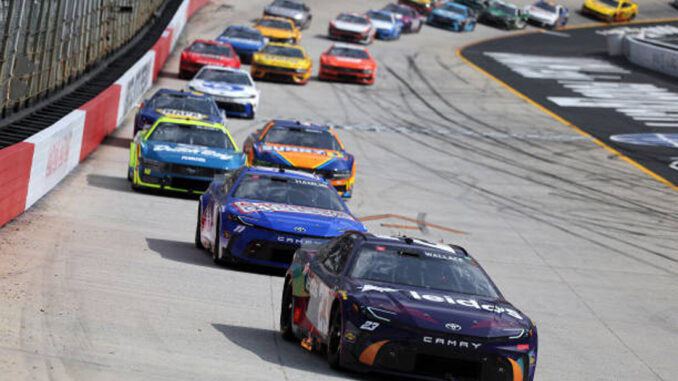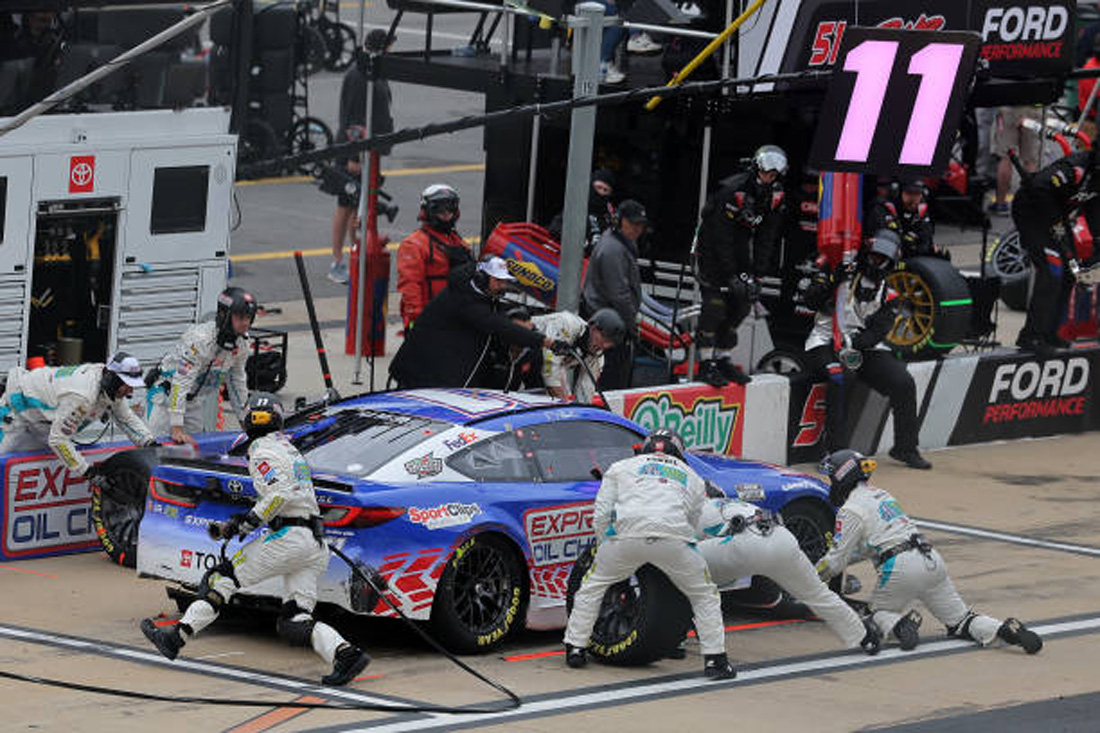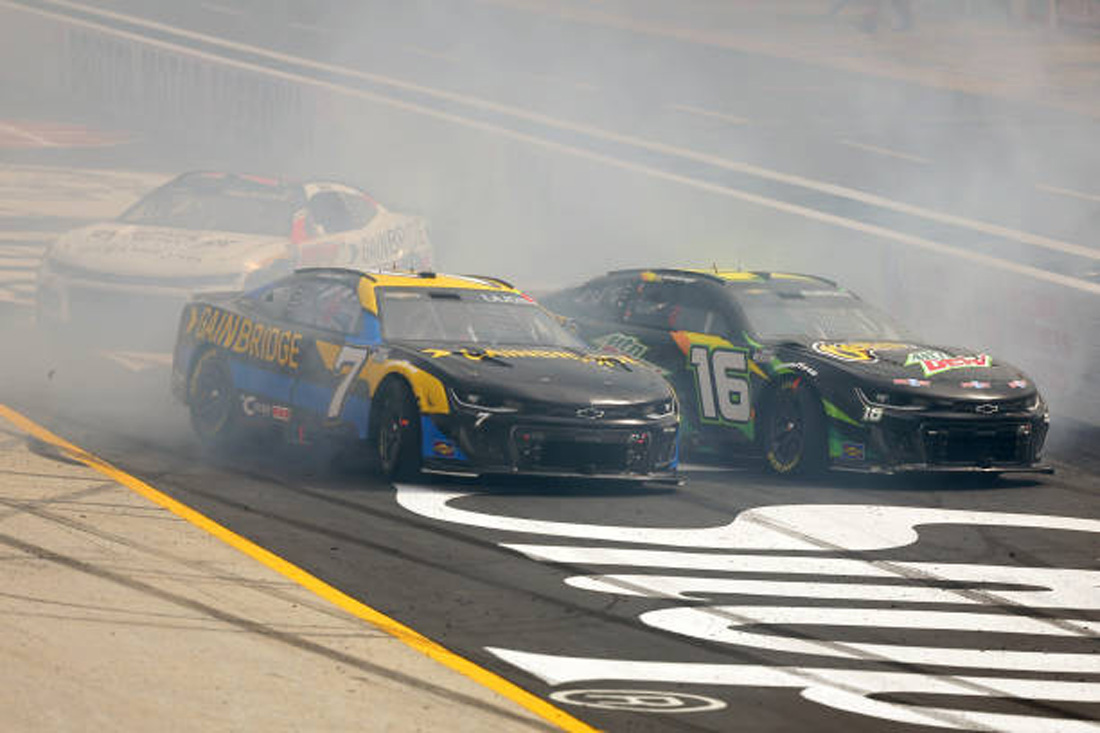
Tires haven’t been the main talking point of a NASCAR race in years.
There are certainly still places like Darlington where a rough surface grinds down the tires and leads to tire wear, and the introduction of the Next Gen car featured a spate of tire blowouts at the end of the 2022 season.
But for the most part, Goodyear brings durable tires to the racetrack that hold up throughout a run and wear at about the same rate, meaning drivers are incentivized to push hard throughout a run. Coupled with cars that are more equal than ever before and low horsepower that limits off-throttle time on most tracks, short-track races with the Next Gen car have seen relatively few comers-and-goers.
Last year’s spring race at Richmond is the perfect example, as the field fell off at the same pace with predictable tire wear that made for a strategy race on pit road rather than a close battle on the track.
Not so at Bristol. The race broke NASCAR’s record for lead changes at a short track with 54. Though a few drivers were caught out by the wear and ended up in the wall, for the most part the race featured comers and goers as drivers embraced a challenge they haven’t faced in years.

Classic style
Race winner Denny Hamlin certainly didn’t walk into that win.
“It was challenging,” Hamlin admitted. “A different kind of challenge, for sure. Certainly not something we’ve had to do for a very long time in managing tires.”
The biggest challenge was how unexpected it all was. Without practice, Cup teams were surprised early on in the race by how much the tires were wearing, and Goodyear had to deliver an additional set of tires to each team to make up for that.
Hamlin acknowledged that the tires weren’t perfect this time around, but said the racing still ended up being better than the alternative.
“Do we want them wearing out in 40, 50 laps? No. That’s probably a little bit on the low end, for sure,” he acknowledged.
“But certainly this is what happens when you get tire wear. There’s comers and goers. I guarantee you, surely you guys at NASCAR have sent out a stat pack of all the passes that happened today. There was times where I was leading, Ty [Gibbs] is just pressuring me. I’m like, ‘No, it’s not time. Go ahead.’ That’s how it used to be. It really used to be that way.”
Denny Hamlin’s crew chief Chris Gabehart also relished the blast from the past.
“It was a blast,” Gabehart said. “I’m not saying that just because we won. I’m saying that because it was fun to do something so unrefined.
“In a lot of ways, it goes back to late model racing because it’s so unrefined that you’ve got to start thinking through it creatively because your simulation tools weren’t planning on this. That makes it a lot of fun.”
A comparison to late model racing on local short tracks throughout the country was a common one throughout the field. It seemed like a sentiment that NASCAR looked like the show plenty of race fans enjoy in their own backyard rather than a strategy race for technologically advanced racing machines.

Rewarding experience
With such a vintage feel to the race, it should be no surprise that some of the sport’s most experienced drivers ended up at the front. Denny Hamlin, Martin Truex Jr, and Brad Keselowski all entered the sport when that sort of racing was the norm.
“It was an interesting race, that’s for sure. Just came up a little bit short there,” runner-up Truex said.
“Early in the race, went way too hard and realized your tires were gone. And then, it’s like ‘alright, we can’t run as hard as we can.’ Just had to figure out how hard you could push it and what kind of lap times you could run throughout the run, then kind of manage it from there,” he explained.
“It was tricky, honestly, I barely pushed harder there on that last run for 10 laps and you know, at the end, I was right rear corded. There’s a fine line and fortunately for us, we had a lot of speed in our Toyotas today and we were able to save tires and stay up front. That was the key.”
Some younger drivers found out the hard way that pure speed wasn’t going to be enough. Ty Gibbs, as Hamlin alluded to, was happy to jump up to the lead and set the pace in the middle but fell back when he ended up tearing up his tires, while Hamlin saved his by running second. A ninth-place recovery was still a strong finish from Gibbs, all things considered.
“I felt like we were great all day, just that last run, the right rear just came apart,” Gibbs explained. “We were just two laps late of coming in. When we had that tire come apart, I think I was like four laps down at one point. Just frustrating but you have to work for it here.”
One young driver who looked like a veteran was John Hunter Nemechek. The rookie driver of the No. 42 relied on his late model experience to understand how the tires worked and finish sixth after running up front throughout.
“I was joking with the guys that it’s just an oversized Pensacola [Five Flags Speedway] with tire wear. I grew up short track late model racing – places that you had to manage tire wear till the end of the run. We were able to do so,” Nemechek explained.
“We were able to finish top-five in both stages and finish sixth overall. Great points day. We definitely needed that as a team.”

Package parity
Unlike the larger mile-long Phoenix Raceway the sport visited last weekend, Bristol didn’t feature the new short track package. After extensive testing, the sanctioning body decided on a new package that features a larger spoiler and less underbody downforce.
At Phoenix, the first test for that new package – it was not yet ready by the Clash at the Coliseum, which featured the same package as Bristol – the Toyotas looked insurmountable. Christopher Bell won that race, and his teammate Hamlin had the speed to finish up front if not for a self-inflicted spin in the latter half of the race.
Here, while the Toyotas also looked like the class of the field, the finishing order is a complete mix of manufacturers. Winner Hamlin and runner-up Truex drove Toyotas, while third-place Brad Keselowski piloted a Ford, and fourth and fifth Alex Bowman and Kyle Larson are both Chevrolet drivers. Those five drivers were the only ones on the lead lap at the end, but the split continued throughout the top ten.
It’s a good thing for Ford especially. Despite Blaney winning last year’s champion driving a Mustang, the brand struggled, especially in the beginning of the season. While a Mustang Dark Horse has yet to go to victory lane, it’s been up front with the Chevys and Toyota all season long.
No more horsepower?
The short track racing package has been a problem since the Next Gen was introduced. The cars are designed to run on road courses, so unlike previous iterations of stock cars, they’re set up to turn both directions and more planted to the track. That means it’s harder to move other drivers out of the grove to set up a pass without just slamming into them – or finding creative workarounds like riding the wall.
Plenty of fans and drivers have highlighted the horsepower. Beginning with the previous generation of cars, NASCAR has limited the power to keep the bunched together. As above, limiting the off-throttle time on all tracks means drivers can run fewer variations of lines and will be inherently closer throughout a long run.
That style has worked well with the Next Gen on 1.5-mile tracks, NASCAR’s bread-and-butter, producing tighter battling that is less dependent on aerodynamics. But it’s made short track races, where drivers traditionally take advantage of mistakes from their competitors like spinning the tires on exit, worse.
The sanctioning body has been reluctant to raise horsepower, citing higher costs, the need for extensive research and development, and the possibility that racing will be less close. Those are valid concerns – Kyle Larson’s domination at North Wilkesboro in the All-Star Race last year may have been truly old-school, but most of the sport’s current fans actually want close racing and competition.
The racing at Bristol seemed to be exactly what those calling for horsepower have asked for. The field separated out with drivers able to put their skills on display, but there was also plenty of passing and battling for the lead. It became, in Hamlin’s words, a “chess match” rather than a parade.
The ball’s in NASCAR’s court now as to where to go next. There are plenty who disliked seeing drivers have to back down their pace and conserve their tires. Rookie driver Carson Hocevar, for one, posted on Twitter his disappointment with his tires blowing after trying to conserve them all race. But for many more, the solution for modern short track problems is to look back to the past.
- The Monster Mile brings short track style to high banking - April 25, 2024
- Sam Mayer scores Xfinity win by an inch in photo finish at Texas - April 13, 2024
- NASCAR adds Stories to its app for social-style highlights - April 10, 2024